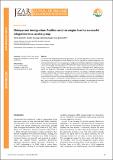Files in this item
Chimpanzee immigration : complex social strategies differ between zoo-based and wild animals
Item metadata
| dc.contributor.author | Goetschi, Florent | |
| dc.contributor.author | McClung, Jennifer | |
| dc.contributor.author | Baumeyer, Adrian | |
| dc.contributor.author | Zuberbuhler, Klaus | |
| dc.date.accessioned | 2020-02-03T10:30:01Z | |
| dc.date.available | 2020-02-03T10:30:01Z | |
| dc.date.issued | 2020-02-01 | |
| dc.identifier.citation | Goetschi , F , McClung , J , Baumeyer , A & Zuberbuhler , K 2020 , ' Chimpanzee immigration : complex social strategies differ between zoo-based and wild animals ' , Journal of Zoo and Aquarium Research , vol. 8 , no. 1 , pp. 10-17 . https://doi.org/10.19227/jzar.v8i1.326 | en |
| dc.identifier.issn | 2214-7594 | |
| dc.identifier.other | PURE: 261215603 | |
| dc.identifier.other | PURE UUID: 7f439989-0eb4-4e82-9798-cee14d3f2ee5 | |
| dc.identifier.other | ORCID: /0000-0001-8378-088X/work/68647683 | |
| dc.identifier.uri | https://hdl.handle.net/10023/19397 | |
| dc.description | The study was funded by an ERC grant (prilang 283871) to KZ and funding from the University of Neuchatel. | en |
| dc.description.abstract | Chimpanzee inter-group encounters are typically aggressive in nature, as individuals have evolved the predisposition to jointly defend their home range against neighbouring groups. In the current study, we present data on the behavioural strategies of chimpanzees (Pan troglodytes) during the integration of one male and two female into a well-established group at Basel Zoo, Switzerland. We found that, shortly after integration, social relationships were generally of better quality in dyads of individuals from the same group than dyads of individuals from different origins. More interestingly, immigrants targeted males as preferred interaction partners, contrary to what is seen in inter-group encounters in the wild. In addition, immigrants also targeted the resident juveniles for play interactions, significantly more so than residents did. The alpha male’s policing of his resident group members further facilitated immigrants’ integration, including the integration of another male. In contrast, both resident and immigrant females had better relationships with members from their own group than with members from other groups. Overall, these diverse behavioural strategies led to the successful long-term integration of the immigrant individuals, a demonstration of the social flexibility of this species orthogonal to their evolved xenophobic propensities. | |
| dc.language.iso | eng | |
| dc.relation.ispartof | Journal of Zoo and Aquarium Research | en |
| dc.rights | Copyright © 2020 The Author(s). Open Access. This article is distributed under the terms of the Creative Commons Attribution 3.0 Unported License (http://creativecommons.org/licenses/by/3.0/), which permits unrestricted use, distribution, and reproduction in any medium, provided you give appropriate credit to the original author(s) and the source, provide a link to the Creative Commons license, and indicate if changes were made. | en |
| dc.subject | Integration | en |
| dc.subject | Policing | en |
| dc.subject | Demonic females | en |
| dc.subject | Inter-group | en |
| dc.subject | Immigration | en |
| dc.subject | Social relationship | en |
| dc.subject | BF Psychology | en |
| dc.subject | QH301 Biology | en |
| dc.subject | NDAS | en |
| dc.subject | SDG 10 - Reduced Inequalities | en |
| dc.subject.lcc | BF | en |
| dc.subject.lcc | QH301 | en |
| dc.title | Chimpanzee immigration : complex social strategies differ between zoo-based and wild animals | en |
| dc.type | Journal article | en |
| dc.description.version | Publisher PDF | en |
| dc.contributor.institution | University of St Andrews. Institute of Behavioural and Neural Sciences | en |
| dc.contributor.institution | University of St Andrews. Centre for Social Learning & Cognitive Evolution | en |
| dc.contributor.institution | University of St Andrews. School of Psychology and Neuroscience | en |
| dc.identifier.doi | https://doi.org/10.19227/jzar.v8i1.326 | |
| dc.description.status | Peer reviewed | en |
| dc.date.embargoedUntil | 2020-01-31 |
This item appears in the following Collection(s)
Items in the St Andrews Research Repository are protected by copyright, with all rights reserved, unless otherwise indicated.

